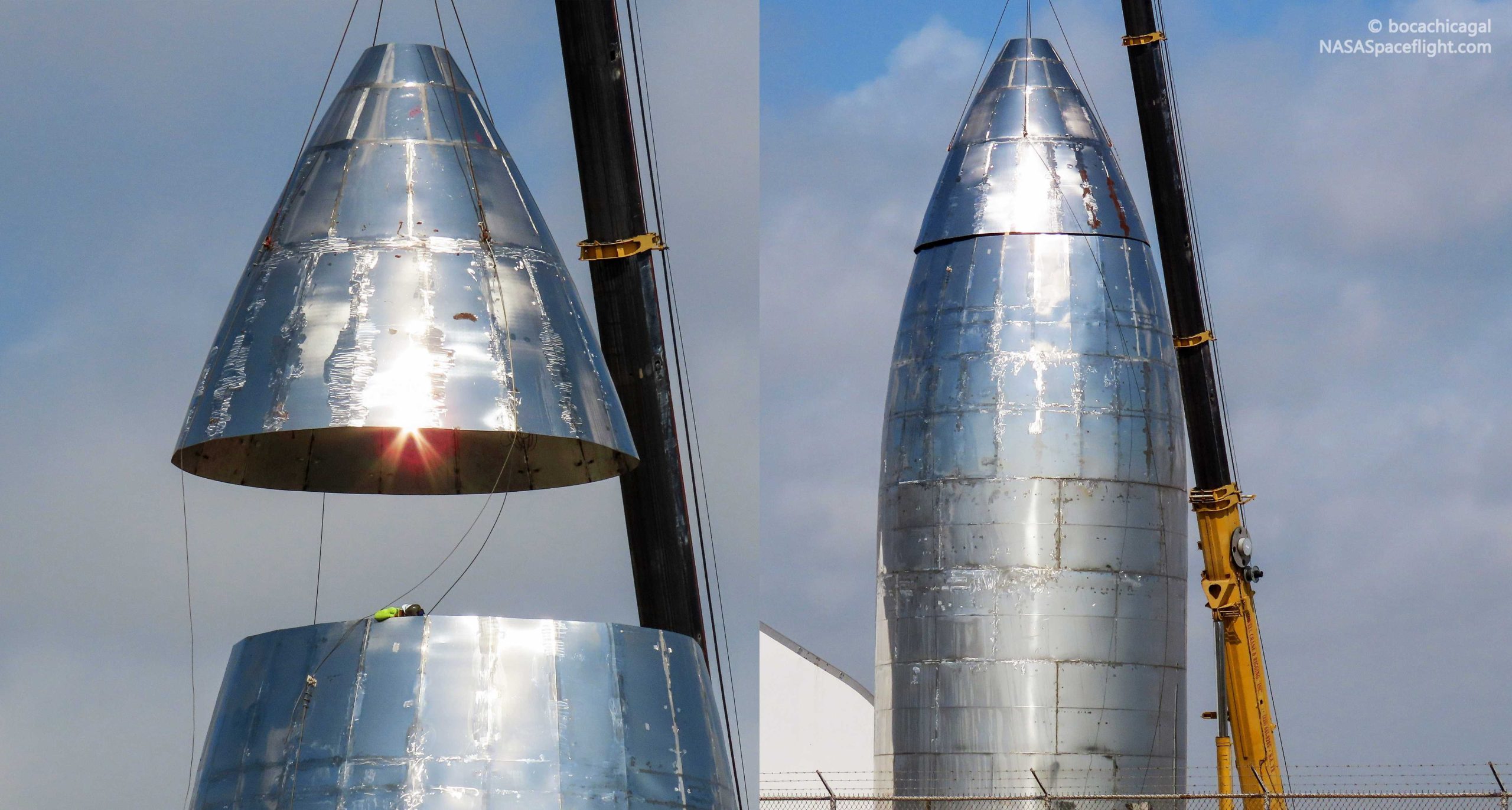
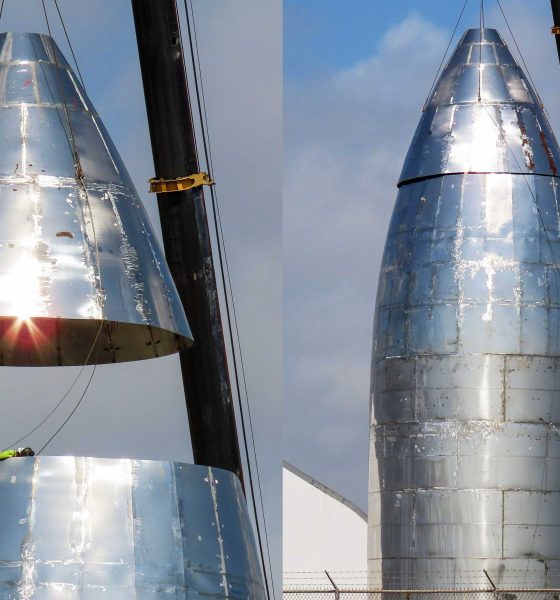
News
SpaceX’s orbital Starship gains a nose as East Coast prototype makes progress
On May 20th, SpaceX technicians successfully stacked a nosecone on top of the company’s Boca Chica orbital Starship prototype. Simultaneously, a separate team of technicians and engineers have been hard at work building a second similar-but-different Starship prototype near Cape Canaveral, Florida.
Officially confirmed last week by Elon Musk, the SpaceX CEO revealed that the company was not only building two orbital Starship prototypes simultaneously – not news in itself – but that those prototypes were being built as a sort of internal competition between different teams and ideas. The competition is not cutthroat – knowledge is shared between Texas and Florida – but the strategy is fairly similar. In lieu of actual commercial competitors, SpaceX is attempting to compete with itself to more rapidly and effectively develop a brand new launch vehicle – the stainless steel Starship/Super Heavy.
A Starship rises in the East
In just the last week, both SpaceX groups have made major progress. On the East Coast, the general public saw the first photo of SpaceX’s Florida Starship build precisely seven days ago. It appears that SpaceX has more or less taken over a Cocoa, Florida facility known to be the prior home of Coastal Steel, a repeat NASA contractor known for steelwork.
It’s unclear if SpaceX has fully acquired Coastal Steel or is simply partnering with the small company in the early stages of its Florida Starship buildup. Regardless, even from perspectives quite a bit more distant than those available in Texas, it’s clear that the metal workmanship is at least on par with Boca Chica, if not giving them a run for their money.
Admittedly, the playing field is not exactly level. SpaceX’s South Texas team has been working just a few thousand feet away from the unobstructed Gulf of Mexico in conditions that would make for an excellent traditional-aerospace horror show. Aside from a lone tent, all welding, assembly, integration, and testing has been done while fully exposed to the elements. SpaceX’s Florida team appears to have the luxury of an established warehouse – previously used for steelwork – to use as a covered and partially insulated work and staging area. The Florida team effectively had everything they needed (give or take) on hand from the moment work began, while Texas had to quite literally build all of its facilities from nothing.
Be it the facility luxuries or Cape Canaveral’s far larger pool of local aerospace talent, it’s clear that SpaceX’s Florida team will be a competitive force to be reckoned with despite Texas’ apparent head start. In the seven days since the first photos of the Florida Starship were published, SpaceX technicians have almost doubled the height of the largest welded section, raising it from ~5.5m to ~9m (18-30 ft).

Meanwhile, those working inside the staging warehouse continue to crank out 2x9m subsections, already making way for what appears to be the first tapered nose section of the Florida Starship. At this rate, Florida could very well catch up to SpaceX’s Texas Starship just a month or two from now. It’s worth noting that the Florida team does not appear to be involved in any Starhopper activities. SpaceX Boca Chica, on the other hand, has spent a major portion of the last several months building out Starhopper and preparing the odd prototype for untethered hop tests.
The (slightly) Old(er) Guard
Despite Starship Florida’s rapid progress, Starship Texas has not exactly been standing around. In the last week or so, SpaceX technicians and engineers have been simultaneously working on major new integration, assembly, and test campaigns with both Starhopper and the first orbital Starship prototype. A dedicated Starhopper article will come later this week as SpaceX’s South Texas team nears Raptor reinstallation and an untethered hop test campaign, scheduled to begin as early as the end of May.

On the orbital Starship side of things, Boca Chica took a major symbolic step towards aeroshell completion by capping off the upper half of the prototype with a stainless steel nose section. Altogether, the Starship assembly now stands about 25m (80 ft) tall from tip to tail, roughly 60% as tall as a Falcon 9 booster (first stage). With the installation of the craft’s nose, SpaceX has also implicitly confirmed that most – if not all – of the Starship prototype’s tankage still needs to be built, unless a great deal of hardware is hiding inside Boca Chica’s on-site tent.
What could either be the orbital Starship’s seven-Raptor engine section or the start of its liquid oxygen or methane tank is also being built a few hundred feet distant. That mystery segment was recently lifted onto a second concrete jig for easier access, while SpaceX has also been hard at work building a dedicated integration facility similar to the warehouse being used in Florida.

Altogether, SpaceX’s South Texas team appears to be 30-40% away from completing a Starship-sized steel aeroshell. A huge amount of work remains to be done on the inside of the theoretically orbit-capable vehicle, including propellant tanks, a thrust structure capable of supporting seven Raptor engines, landing legs/fins, and a jungle of plumbing and avionics installation. Still, the amount of progress already visible is undeniably impressive, made even more intriguing by the existence of a separate Starship build effort to the east.
Check out Teslarati’s Marketplace! We offer Tesla accessories, including for the Tesla Cybertruck and Tesla Model 3.

News
Tesla 2025 Holiday Update: Here’s what it includes, and what it’s missing
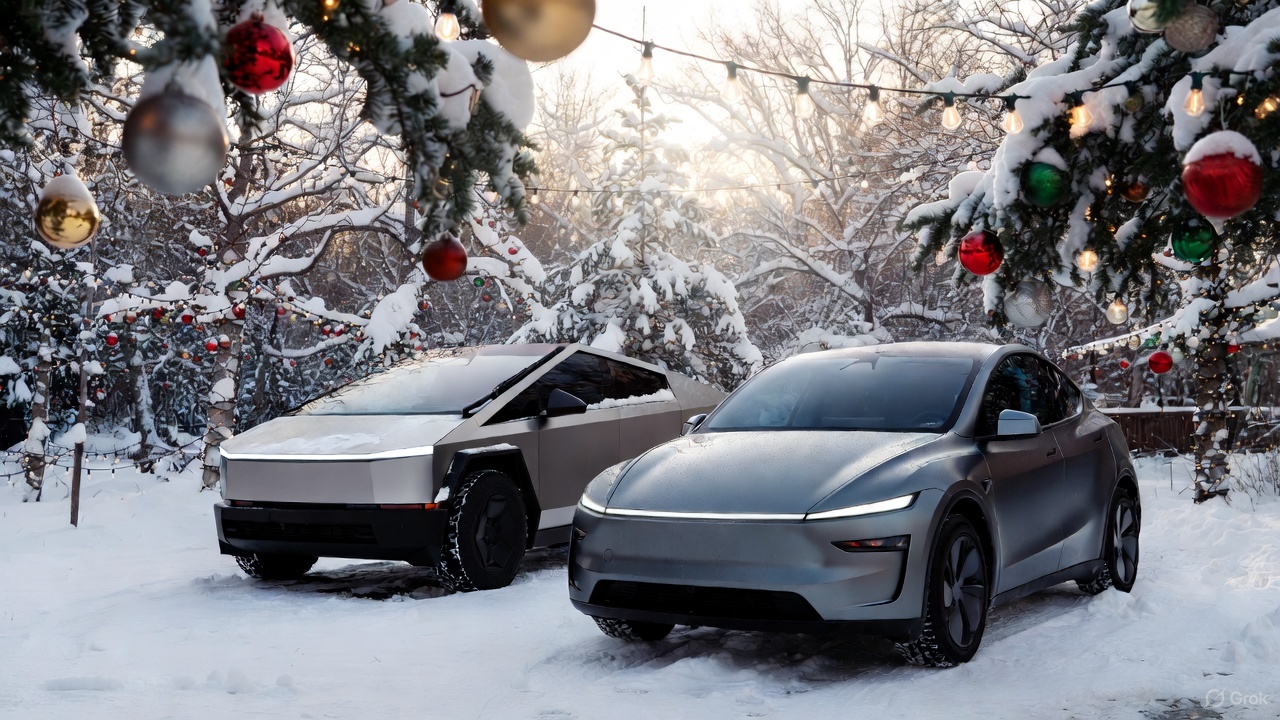
Tesla has finally announced the features for the 2025 Holiday Update, which includes a wide variety of new inclusions that are both functional and just for fun.
The new features are plentiful, but there were a handful of things we were expecting to see based on what we know. We don’t want to sound ungrateful, because there are a lot of great new things on the way with this update.
Here’s what was included:
Grok with Navigation Commands (Beta)
Grok will now have the ability to add and edit navigation destinations, which is a drastic improvement considering Tesla owners had to use their standard voice commands for this in the past.

The utilization of Grok will likely improve the navigation experience by offering some insight into your destination, including reviews and other points of interest nearby.
It will be enabled by using Grok’s “Assistant” personality.
Tesla Photobooth
“Turn your car into a photobooth! Take selfies from inside your Tesla & give yourself a makeover with fun filters, stickers, and emojis. Share with others right from the Tesla app.”
This feature will be available within the Toybox.
Dog Mode Live Activity
When using Dog Mode to keep your four-legged friend comfortable in the car, you’ll now be able to check in on them as it will share periodic snapshots of the cabin, along with live updates on temperature, battery, and climate conditions.
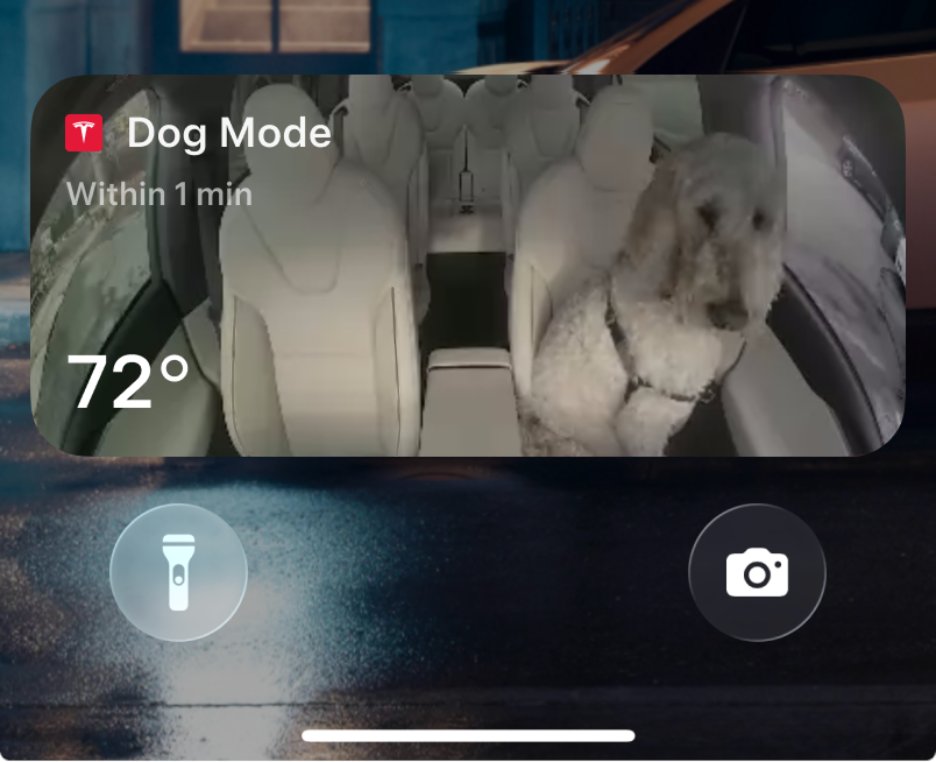
Dashcam Viewer Update
Dashcam clips are awesome, but they’re void of a lot of information, which could be useful in some instances, especially if there is an accident.
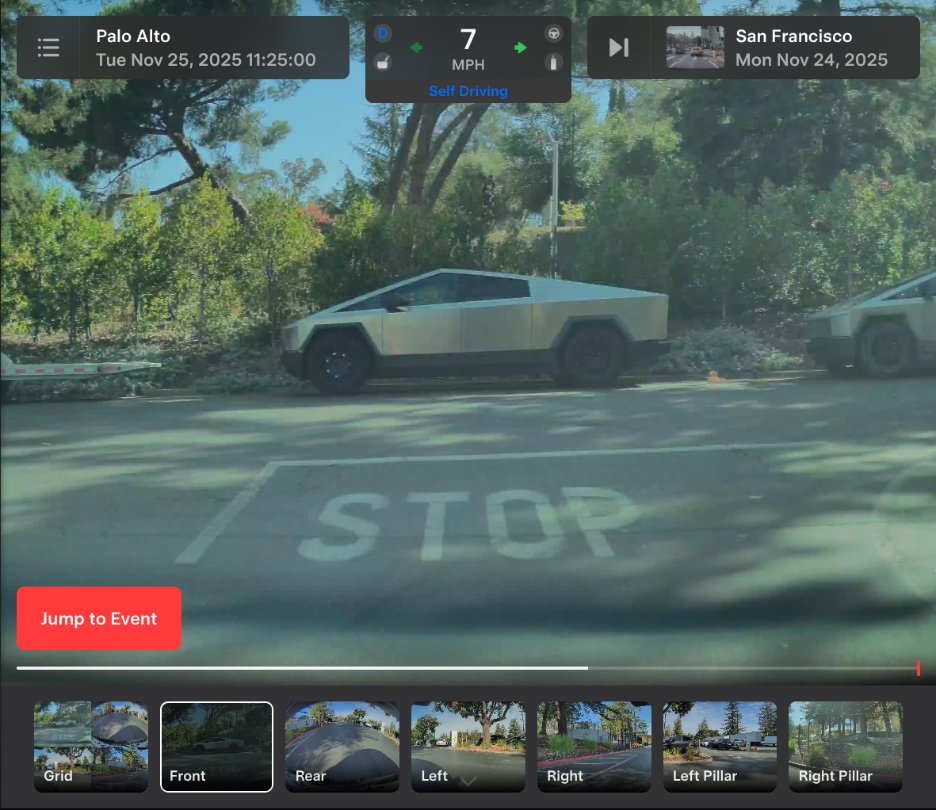
Now, there will be additional details included on each Dashcam clip, like speed, steering wheel angle, and Self-Driving state.
Santa Mode
New graphics, trees, and a lock chime are now available.

Light Show Update
A new Light Show, called Jingle Rush, will be available.
Custom Wraps and License Plates in Colorizer
Colorizer will now be known as “Paint Shop” in the Toybox. You will now be able to personalize your Tesla Avatar with window tints, custom wraps, and license plates. Preloaded designs will be available, but owners will be able to use their USB Flash Drives to create one that suits their style.
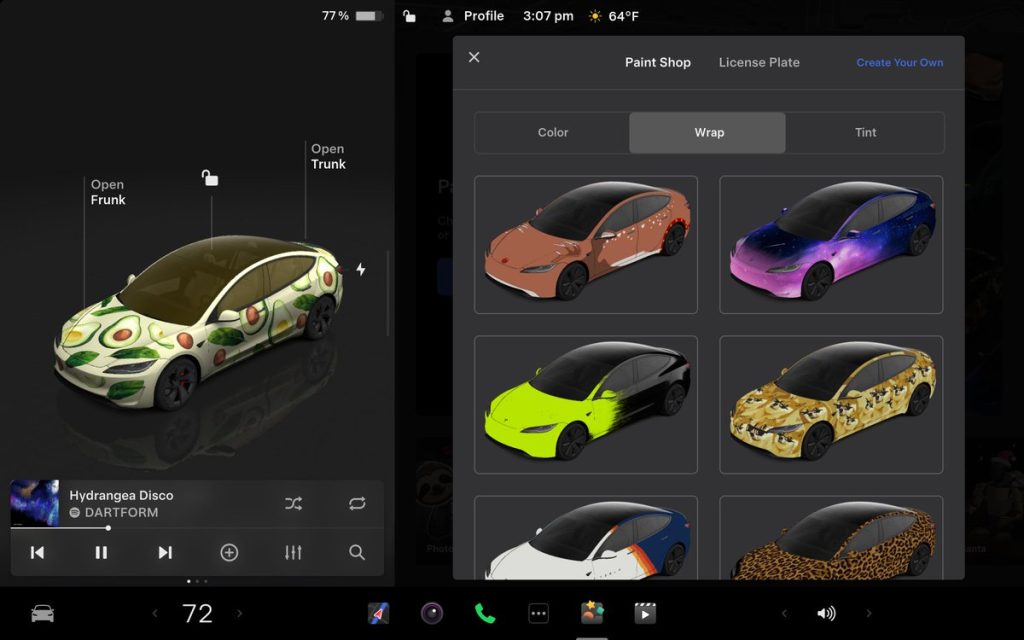
Navigation Improvements
Changing the order of your destinations will be easier through a new “Favorites” tab, and Home and Work can now be set by dropping a pin.
There will also be “Suggested Destinations,” which will be determined through recent trips and habits while parked.
Supercharger Site Map
Perhaps the most significant feature of the Holiday Update, Tesla is adding a 3D view of select Tesla Superchargers by tapping “View Site Map.”
When navigating to a location with this capability, the site layout, live occupancy, and nearby amenities will be available. Drivers will also be able to choose which stall to Supercharge.
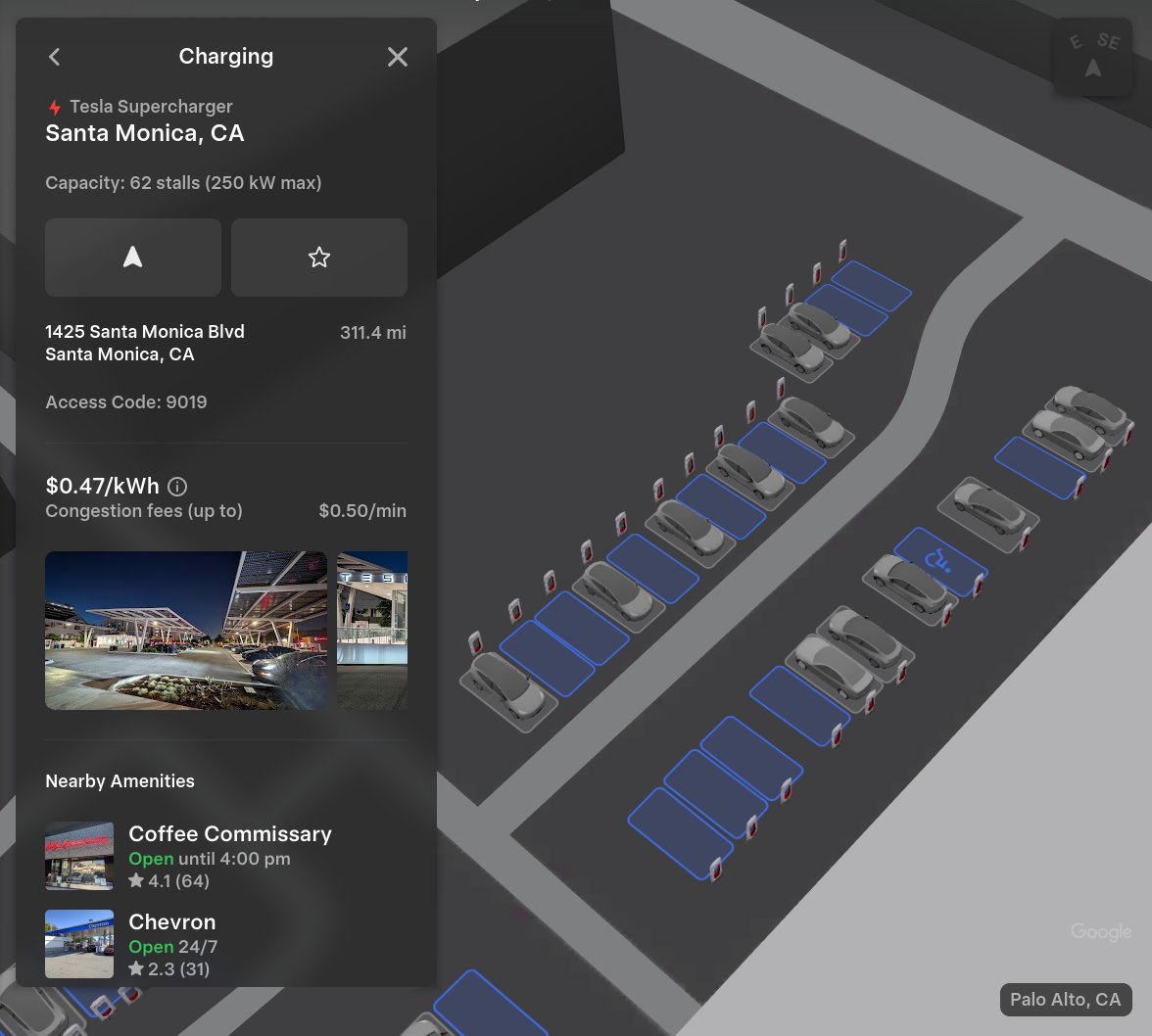
This is only available at a handful of locations currently, but it will expand to more Superchargers as it becomes more robust.
Automatic Carpool Lane Routing
Navigation will include an option to utilize carpool lanes. Your route will automatically choose the carpool lane when eligible.
Phone Left Behind Chime
If the in-car occupant detection system does not see anyone in the car and there is a phone key, or if a phone is left inside the cabin, your Tesla will chime a few seconds after the doors close.
Charge Limit Per Location
You can now save a charge limit for the current location while parked and it will be applied automatically the next time you charge there.
ISS Docking Simulator
In a SpaceX collaboration, Tesla has added this game to its in-car Arcade:
“Become an astronaut and prove your skills by docking with the International Space Station. Control & guide the rocket in this 3D docking simulator game using a set of controls based on actual interfaces used by NASA astronauts.”
Additional Improvements
-
Enable or disable wireless phone charging pads in Controls > Charging (S3XY) or Controls > Outlets & Mods (Cybertruck)
-
Add Spotify tracks to your queue right from the search screen & scroll through large Spotify playlists, albums, podcasts, audiobooks & your library seamlessly, without paging
-
Take the vibes up another level with rainbow colors during Rave Cave. Accent lights color will change along with the beats of your music. App Launcher > Toybox > Light Sync
-
Lock Sound now includes Light Cycle from Tron Mode. Toybox > Boombox > Lock Sound
What’s Missing
There are a handful of features we expected to see with the Holiday Update, but were not included.
Banish Feature
Tesla has been teasing the Banish functionality for quite a few years, but evidently, it is not quite there yet.
Banish will allow owners to get out of their vehicle at the entrance of their destination, and the car will go find a spot and park itself. Some refer to it as “Reverse Summon.”
Apple CarPlay
With all of the rumors regarding Apple CarPlay and then the evidence that Tesla was working to bring CarPlay to vehicles, we really expected it to come with the Holiday Update.
We’re not upset it’s not here, though. Tesla’s in-car UI is significantly better, at least in our opinion.
Parking Spot Selection
One of the biggest gripes about the new Arrival Features with Full Self-Driving v14 is that choosing a set parking spot is not available. This is especially frustrating for Tesla owners who rent or live in townhouse neighborhoods or apartment complexes with assigned parking.
Tesla seems to be working on this based on the release notes for v14.2, where it said future capabilities would include Parking Spot Selection.
News
Man credits Grok AI with saving his life after ER missed near-ruptured appendix
The AI flagged some of the man’s symptoms and urged him to return to the ER immediately and demand a CT scan.

A 49-year-old man has stated that xAI’s Grok ended up saving his life when the large language model identified a near-ruptured appendix that his first ER visit dismissed as acid reflux.
After being sent home from the ER, the man asked Grok to analyze his symptoms. The AI flagged some of the man’s symptoms and urged him to return immediately and demand a CT scan. The scan confirmed that something far worse than acid reflux was indeed going on.
Grok spotted what a doctor missed
In a post on Reddit, u/Tykjen noted that for 24 hours straight, he had a constant “razor-blade-level” abdominal pain that forced him into a fetal position. He had no fever or visible signs. He went to the ER, where a doctor pressed his soft belly, prescribed acid blockers, and sent him home.
The acid blockers didn’t work, and the man’s pain remained intense. He then decided to open a year-long chat he had with Grok and listed every detail that he was experiencing. The AI responded quickly. “Grok immediately flagged perforated ulcer or atypical appendicitis, told me the exact red-flag pattern I was describing, and basically said “go back right now and ask for a CT,” the man wrote in his post.
He copied Grok’s reasoning, returned to the ER, and insisted on the scan. The CT scan ultimately showed an inflamed appendix on the verge of rupture. Six hours later, the appendix was out. The man said the pain has completely vanished, and he woke up laughing under anesthesia. He was discharged the next day.
How a late-night conversation with Grok got me to demand the CT scan that saved my life from a ruptured appendix (December 2025)
byu/Tykjen ingrok
AI doctors could very well be welcomed
In the replies to his Reddit post, u/Tykjen further explained that he specifically avoided telling doctors that Grok, an AI, suggested he get a CT scan. “I did not tell them on the second visit that Grok recommended the CT scan. I had to lie. I told them my sister who’s a nurse told me to ask for the scan,” the man wrote.
One commenter noted that the use of AI in medicine will likely be welcomed, stating that “If AI could take doctors’ jobs one day, I will be happy. Doctors just don’t care anymore. It’s all a paycheck.” The Redditor replied with, “Sadly yes. That is what it felt like after the first visit. And the following night could have been my last.”
Elon Musk has been very optimistic about the potential of robots like Tesla Optimus in the medical field. Provided that they are able to achieve human-level articulation in their hands, and Tesla is able to bring down their cost through mass manufacturing, the era of AI-powered medical care could very well be closer than expected.
News
Tesla expands Model 3 lineup in Europe with most affordable variant yet
The Model 3 Standard still delivers more than 300 miles of range, potentially making it an attractive option for budget-conscious buyers.

Tesla has introduced a lower-priced Model 3 variant in Europe, expanding the lineup just two months after the vehicle’s U.S. debut. The Model 3 Standard still delivers more than 300 miles (480 km) of range, potentially making it an attractive option for budget-conscious buyers.
Tesla’s pricing strategy
The Model 3 Standard arrives as Tesla contends with declining registrations in several countries across Europe, where sales have not fully offset shifting consumer preferences. Many buyers have turned to options such as Volkswagen’s ID.3 and BYD’s Atto 3, both of which have benefited from aggressive pricing.
By removing select premium finishes and features, Tesla positioned the new Model 3 Standard as an “ultra-low cost of ownership” option of its all-electric sedan. Pricing comes in at €37,970 in Germany, NOK 330,056 in Norway, and SEK 449,990 in Sweden, depending on market. This places the Model 3 Standard well below the “premium” Model 3 trim, which starts at €45,970 in Germany.
Deliveries for the Standard model are expected to begin in the first quarter of 2026, giving Tesla an entry-level foothold in a segment that’s increasingly defined by sub-€40,000 offerings.
Tesla’s affordable vehicle push
The low-cost Model 3 follows October’s launch of a similarly positioned Model Y variant, signaling a broader shift in Tesla’s product strategy. While CEO Elon Musk has moved the company toward AI-driven initiatives such as robotaxis and humanoid robots, lower-priced vehicles remain necessary to support the company’s revenue in the near term.
Reports have indicated that Tesla previously abandoned plans for an all-new $25,000 EV, with the company opting to create cheaper versions of existing platforms instead. Analysts have flagged possible cannibalization of higher-margin models, but the move aims to counter an influx of aggressively priced entrants from China and Europe, many of which sell below $30,000. With the new Model 3 Standard, Tesla is reinforcing its volume strategy in Europe’s increasingly competitive EV landscape.








